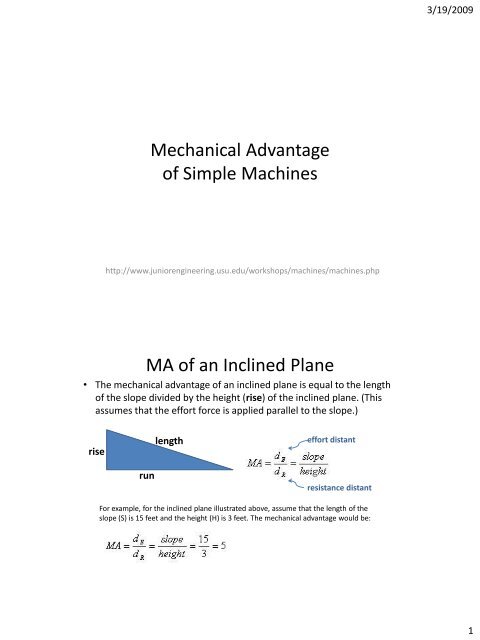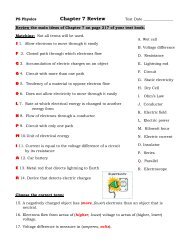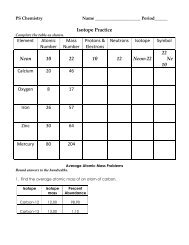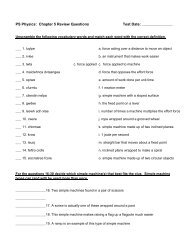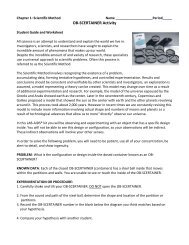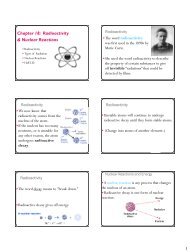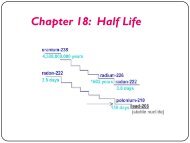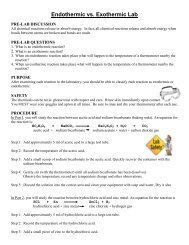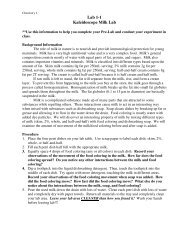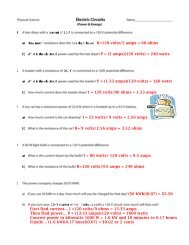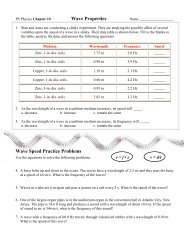Mechanical Advantage of Simple Machines MA of an Inclined Plane
Mechanical Advantage of Simple Machines MA of an Inclined Plane
Mechanical Advantage of Simple Machines MA of an Inclined Plane
You also want an ePaper? Increase the reach of your titles
YUMPU automatically turns print PDFs into web optimized ePapers that Google loves.
3/19/2009<br />
<strong>Mech<strong>an</strong>ical</strong> <strong>Adv<strong>an</strong>tage</strong><br />
<strong>of</strong> <strong>Simple</strong> <strong>Machines</strong><br />
http://www.juniorengineering.usu.edu/workshops/machines/machines.php<br />
<strong>MA</strong> <strong>of</strong> <strong>an</strong> <strong>Inclined</strong> Pl<strong>an</strong>e<br />
• The mech<strong>an</strong>ical adv<strong>an</strong>tage <strong>of</strong> <strong>an</strong> inclined pl<strong>an</strong>e is equal to the length<br />
<strong>of</strong> the slope divided by the height (rise) <strong>of</strong> the inclined pl<strong>an</strong>e. (This<br />
assumes that the effort force is applied parallel to the slope.)<br />
rise<br />
length<br />
effort dist<strong>an</strong>t<br />
run<br />
resist<strong>an</strong>ce dist<strong>an</strong>t<br />
For example, for the inclined pl<strong>an</strong>e illustrated above, assume that the length <strong>of</strong> the<br />
slope (S) is 15 feet <strong>an</strong>d the height (H) is 3 feet. The mech<strong>an</strong>ical adv<strong>an</strong>tage would be:<br />
1
3/19/2009<br />
• While the inclined pl<strong>an</strong>e produces a mech<strong>an</strong>ical adv<strong>an</strong>tage, making<br />
it feel like it is easier to "lift" the object, it does so by increasing the<br />
dist<strong>an</strong>ce through which the force must move. In the above situation<br />
the mech<strong>an</strong>ical adv<strong>an</strong>tage <strong>of</strong> 5 multiplies our effort force five fold,<br />
but we have to pay for it by moving five times as far. In other words,<br />
if you c<strong>an</strong> lift a 50 kg drum from the ground up onto a one meter<br />
tall platform, using the inclined pl<strong>an</strong>e above would allow you roll a<br />
250 kg drum up the ramp to a height <strong>of</strong> one meter, but you would<br />
have to roll it for 5 meters.<br />
Practice:<br />
A 6 meter ramp runs from a ground-level sidewalk to a porch. The porch is 2<br />
meters <strong>of</strong>f the ground. What is the mech<strong>an</strong>ical adv<strong>an</strong>tage <strong>of</strong> the ramp?<br />
<strong>MA</strong> <strong>of</strong> a Wedge<br />
• The mech<strong>an</strong>ical adv<strong>an</strong>tage <strong>of</strong> a wedge c<strong>an</strong><br />
be found by dividing the length <strong>of</strong> the slope<br />
(S) by the thickness (T) <strong>of</strong> the big end.<br />
thickness<br />
For example, assume that the length <strong>of</strong> the slope is 20 cm <strong>an</strong>d the<br />
thickness is 5 cm. The mech<strong>an</strong>ical adv<strong>an</strong>tage is equal to 20/5 = 4. As<br />
with the inclined pl<strong>an</strong>e, the mech<strong>an</strong>ical adv<strong>an</strong>tage gained by using a<br />
wedge requires a corresponding increase in effort dist<strong>an</strong>ce. In this<br />
case for every 20 cm you drive the wedge you spread the log 5 cm.<br />
2
3/19/2009<br />
• Which <strong>of</strong> these wedges has the<br />
greatest mech<strong>an</strong>ical adv<strong>an</strong>tage?<br />
If you picked A you are correct. Since A is "sharper", it will be<br />
easier to drive into the log. However, it may not have enough<br />
"pushing" ability to split the log. Wedge B would be much<br />
harder to drive into the log, but it clearly has more capability for<br />
splitting the log due to its greater thickness at the top.<br />
<strong>MA</strong> <strong>of</strong> a Screw<br />
The vertical dist<strong>an</strong>ce between two adjacent screw threads is called<br />
the pitch <strong>of</strong> a screw. One complete revolution <strong>of</strong> the screw will move<br />
it into <strong>an</strong> object a dist<strong>an</strong>ce equal to the pitch <strong>of</strong> the screw. As <strong>an</strong><br />
example, assume that you place a ruler parallel to a screw <strong>an</strong>d count<br />
10 threads in a dist<strong>an</strong>ce <strong>of</strong> one inch. The pitch <strong>of</strong> the screw would be<br />
1/10. Since there are 10 threads per inch <strong>of</strong> screw, the dist<strong>an</strong>ce<br />
between two adjacent screw threads is 1/10 <strong>of</strong> <strong>an</strong> inch. Also,<br />
remember that one complete revolution <strong>of</strong> a screw will move the<br />
screw into <strong>an</strong> object a dist<strong>an</strong>ce equal to the pitch <strong>of</strong> the screw.<br />
Therefore, one complete revolution will move a screw with 1/10 pitch<br />
a dist<strong>an</strong>ce <strong>of</strong> 1/10 <strong>of</strong> <strong>an</strong> inch into <strong>an</strong> object.<br />
In the United States, the convention for describing threads is to give<br />
the number <strong>of</strong> threads per inch. So, for example, in the United States<br />
one might ask for a "2-inch quarter-twenty bolt," which would be<br />
• 2 inches long<br />
• have a diameter <strong>of</strong> a quarter <strong>of</strong> <strong>an</strong> inch<br />
• have twenty threads to the inch<br />
3
3/19/2009<br />
• Metric sizes are described in a different way,<br />
for example "M3.5 × 1.2". The number<br />
following "M" is the diameter in millimeters;<br />
the number following "×" is the pitch (also in<br />
millimeters), which is the dist<strong>an</strong>ce from one<br />
thread to the corresponding point on the next<br />
thread.<br />
• The mech<strong>an</strong>ical adv<strong>an</strong>tage <strong>of</strong> a screw c<strong>an</strong> be<br />
found by dividing the circumference <strong>of</strong> the<br />
screw by the pitch <strong>of</strong> the screw. The gentler<br />
the pitch (i.e. finer the thread), the easier it<br />
moves, but you have to make a lot <strong>of</strong> turns.<br />
<strong>MA</strong> <strong>of</strong> a Lever<br />
• The mech<strong>an</strong>ical adv<strong>an</strong>tage <strong>of</strong> a lever is the ratio <strong>of</strong> the length <strong>of</strong> the<br />
effort arm divided by the length <strong>of</strong> the resist<strong>an</strong>ce arm. The arm is<br />
measured from the fulcrum to the point <strong>of</strong> effort or resist<strong>an</strong>ce, as<br />
the case may be.<br />
1 st Class Lever<br />
2nd Class Lever<br />
3rd Class Lever<br />
4
3/19/2009<br />
<strong>MA</strong> <strong>of</strong> a Pulley<br />
• A pulley is said to be a fixed pulley if it does not rise or fall<br />
with the load being moved. A fixed pulley ch<strong>an</strong>ges the<br />
direction <strong>of</strong> a force; however, it does not create a mech<strong>an</strong>ical<br />
adv<strong>an</strong>tage. It does however, allow one to take adv<strong>an</strong>tage <strong>of</strong><br />
gravity instead <strong>of</strong> working against it when lifting <strong>an</strong> object. A<br />
fixed pulley is illustrated below.<br />
• A moveable pulley rises <strong>an</strong>d falls with the load that is being<br />
moved. A single moveable pulley creates a mech<strong>an</strong>ical<br />
adv<strong>an</strong>tage; however, it does not ch<strong>an</strong>ge the direction <strong>of</strong> force.<br />
The mech<strong>an</strong>ical adv<strong>an</strong>tage <strong>of</strong> a moveable pulley is roughly equal to the<br />
number <strong>of</strong> ropes that support the moveable pulley. (When calculating<br />
the mech<strong>an</strong>ical adv<strong>an</strong>tage <strong>of</strong> a moveable pulley, count each end <strong>of</strong> the<br />
rope as a separate rope). As shown in the following illustration, two<br />
rope ends support the moveable pulley, thus the <strong>MA</strong> is 2<br />
5
3/19/2009<br />
• One way to think <strong>of</strong> this is in terms <strong>of</strong> carrying <strong>an</strong> ambul<strong>an</strong>ce gurney,<br />
a stretcher, or a casket. If the load is 100 kg <strong>an</strong>d one person has to lift<br />
it, that person lifts all 100 kg. If two people lift the load each person<br />
only needs to lift 50 kg. If four people are lifting each one only has to<br />
lift 25 kg, <strong>an</strong>d so on. The load is distributed equally among each<br />
person lifting. In a movable pulley system you c<strong>an</strong> think <strong>of</strong> each<br />
supporting rope as a person helping to lift the load.<br />
Practice:<br />
What is the mech<strong>an</strong>ical adv<strong>an</strong>tage <strong>of</strong> the pulley system?<br />
<strong>MA</strong> <strong>of</strong> a Wheel <strong>an</strong>d Axle<br />
The mech<strong>an</strong>ical adv<strong>an</strong>tage <strong>of</strong> a wheel<br />
<strong>an</strong>d axle is the ratio <strong>of</strong> the radius <strong>of</strong><br />
the wheel to the radius <strong>of</strong> the axle<br />
The <strong>MA</strong> <strong>of</strong> 5 in this case me<strong>an</strong>s that the in<br />
one full rotation the wheel <strong>an</strong>d axle both turn<br />
360 degrees, but the wheel travels 5 times<br />
farther th<strong>an</strong> the axle during that one rotation.<br />
The pay-out is that the torque on the axle is 5<br />
times greater th<strong>an</strong> the effort applied to the<br />
wheel. In the days before power steering it<br />
was not uncommon to have a steering wheel<br />
with a <strong>MA</strong> <strong>of</strong> 20, most modern car steering<br />
wheels have <strong>an</strong> <strong>MA</strong> <strong>of</strong> 13.<br />
6
3/19/2009<br />
Practice:<br />
7


